[English] 日本語
 Yorodumi
Yorodumi- PDB-5vku: An atomic structure of the human cytomegalovirus (HCMV) capsid wi... -
+ Open data
Open data
- Basic information
Basic information
| Entry | Database: PDB / ID: 5vku | |||||||||||||||||||||
|---|---|---|---|---|---|---|---|---|---|---|---|---|---|---|---|---|---|---|---|---|---|---|
| Title | An atomic structure of the human cytomegalovirus (HCMV) capsid with its securing layer of pp150 tegument protein | |||||||||||||||||||||
 Components Components |
| |||||||||||||||||||||
 Keywords Keywords | VIRUS / icosahedral / capsid / tegument / Herpesvirus | |||||||||||||||||||||
| Function / homology |  Function and homology information Function and homology informationhost cell viral assembly compartment / T=16 icosahedral viral capsid / viral tegument / viral capsid assembly / host cell cytoplasmic vesicle / viral process / viral capsid / host cell perinuclear region of cytoplasm / host cell nucleus / structural molecule activity / DNA binding Similarity search - Function | |||||||||||||||||||||
| Biological species |   Human cytomegalovirus Human cytomegalovirus | |||||||||||||||||||||
| Method | ELECTRON MICROSCOPY / single particle reconstruction / cryo EM / Resolution: 3.9 Å | |||||||||||||||||||||
 Authors Authors | Yu, X. / Jih, J. / Jiang, J. / Zhou, H. | |||||||||||||||||||||
| Funding support |  United States, 6items United States, 6items
| |||||||||||||||||||||
 Citation Citation |  Journal: Science / Year: 2017 Journal: Science / Year: 2017Title: Atomic structure of the human cytomegalovirus capsid with its securing tegument layer of pp150. Authors: Xuekui Yu / Jonathan Jih / Jiansen Jiang / Z Hong Zhou /  Abstract: Herpesviruses possess a genome-pressurized capsid. The 235-kilobase genome of human cytomegalovirus (HCMV) is by far the largest of any herpesvirus, yet it has been unclear how its capsid, which is ...Herpesviruses possess a genome-pressurized capsid. The 235-kilobase genome of human cytomegalovirus (HCMV) is by far the largest of any herpesvirus, yet it has been unclear how its capsid, which is similar in size to those of other herpesviruses, is stabilized. Here we report a HCMV atomic structure consisting of the herpesvirus-conserved capsid proteins MCP, Tri1, Tri2, and SCP and the HCMV-specific tegument protein pp150-totaling ~4000 molecules and 62 different conformers. MCPs manifest as a complex of insertions around a bacteriophage HK97 gp5-like domain, which gives rise to three classes of capsid floor-defining interactions; triplexes, composed of two "embracing" Tri2 conformers and a "third-wheeling" Tri1, fasten the capsid floor. HCMV-specific strategies include using hexon channels to accommodate the genome and pp150 helix bundles to secure the capsid via cysteine tetrad-to-SCP interactions. Our structure should inform rational design of countermeasures against HCMV, other herpesviruses, and even HIV/AIDS. | |||||||||||||||||||||
| History |
|
- Structure visualization
Structure visualization
| Movie |
 Movie viewer Movie viewer |
|---|---|
| Structure viewer | Molecule:  Molmil Molmil Jmol/JSmol Jmol/JSmol |
- Downloads & links
Downloads & links
- Download
Download
| PDBx/mmCIF format |  5vku.cif.gz 5vku.cif.gz | 5.9 MB | Display |  PDBx/mmCIF format PDBx/mmCIF format |
|---|---|---|---|---|
| PDB format |  pdb5vku.ent.gz pdb5vku.ent.gz | Display |  PDB format PDB format | |
| PDBx/mmJSON format |  5vku.json.gz 5vku.json.gz | Tree view |  PDBx/mmJSON format PDBx/mmJSON format | |
| Others |  Other downloads Other downloads |
-Validation report
| Summary document |  5vku_validation.pdf.gz 5vku_validation.pdf.gz | 1.8 MB | Display |  wwPDB validaton report wwPDB validaton report |
|---|---|---|---|---|
| Full document |  5vku_full_validation.pdf.gz 5vku_full_validation.pdf.gz | 1.8 MB | Display | |
| Data in XML |  5vku_validation.xml.gz 5vku_validation.xml.gz | 637.1 KB | Display | |
| Data in CIF |  5vku_validation.cif.gz 5vku_validation.cif.gz | 1023.3 KB | Display | |
| Arichive directory |  https://data.pdbj.org/pub/pdb/validation_reports/vk/5vku https://data.pdbj.org/pub/pdb/validation_reports/vk/5vku ftp://data.pdbj.org/pub/pdb/validation_reports/vk/5vku ftp://data.pdbj.org/pub/pdb/validation_reports/vk/5vku | HTTPS FTP |
-Related structure data
| Related structure data |  8703MC M: map data used to model this data C: citing same article ( |
|---|---|
| Similar structure data |
- Links
Links
- Assembly
Assembly
| Deposited unit | 
|
|---|---|
| 1 | x 60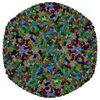
|
| 2 |
|
| 3 | x 5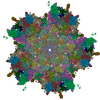
|
| 4 | x 6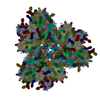
|
| 5 | 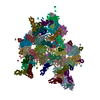
|
| Symmetry | Point symmetry: (Schoenflies symbol: I (icosahedral)) |
- Components
Components
| #1: Protein | Mass: 33232.418 Da / Num. of mol.: 15 / Fragment: UNP residues 1-285 / Source method: isolated from a natural source / Source: (natural)   Human cytomegalovirus (strain AD169) / Strain: AD169 / References: UniProt: P08318 Human cytomegalovirus (strain AD169) / Strain: AD169 / References: UniProt: P08318#2: Protein | Mass: 154048.906 Da / Num. of mol.: 16 / Source method: isolated from a natural source / Source: (natural)   Human cytomegalovirus (strain AD169) / Strain: AD169 / References: UniProt: P16729 Human cytomegalovirus (strain AD169) / Strain: AD169 / References: UniProt: P16729#3: Protein | Mass: 8495.924 Da / Num. of mol.: 16 / Source method: isolated from a natural source / Source: (natural)   Human cytomegalovirus (strain AD169) / Strain: AD169 / References: UniProt: Q7M6N6 Human cytomegalovirus (strain AD169) / Strain: AD169 / References: UniProt: Q7M6N6#4: Protein | Mass: 33071.270 Da / Num. of mol.: 5 / Source method: isolated from a natural source / Source: (natural)   Human cytomegalovirus (strain AD169) / Strain: AD169 / References: UniProt: P16783 Human cytomegalovirus (strain AD169) / Strain: AD169 / References: UniProt: P16783#5: Protein | Mass: 34635.750 Da / Num. of mol.: 10 / Source method: isolated from a natural source / Source: (natural)   Human cytomegalovirus (strain AD169) / Strain: AD169 / References: UniProt: P16728 Human cytomegalovirus (strain AD169) / Strain: AD169 / References: UniProt: P16728 |
|---|
-Experimental details
-Experiment
| Experiment | Method: ELECTRON MICROSCOPY |
|---|---|
| EM experiment | Aggregation state: PARTICLE / 3D reconstruction method: single particle reconstruction |
- Sample preparation
Sample preparation
| Component | Name: Human herpesvirus 5 strain AD169 / Type: VIRUS / Entity ID: all / Source: NATURAL |
|---|---|
| Source (natural) | Organism:   Human cytomegalovirus (strain AD169) Human cytomegalovirus (strain AD169) |
| Details of virus | Empty: NO / Enveloped: YES / Isolate: STRAIN / Type: VIRION |
| Virus shell | Diameter: 1320 nm / Triangulation number (T number): 16 |
| Buffer solution | pH: 7.4 |
| Specimen | Embedding applied: NO / Shadowing applied: NO / Staining applied: NO / Vitrification applied: YES |
| Vitrification | Cryogen name: ETHANE |
- Electron microscopy imaging
Electron microscopy imaging
| Experimental equipment |  Model: Titan Krios / Image courtesy: FEI Company |
|---|---|
| Microscopy | Model: FEI TITAN KRIOS |
| Electron gun | Electron source:  FIELD EMISSION GUN / Accelerating voltage: 300 kV / Illumination mode: FLOOD BEAM FIELD EMISSION GUN / Accelerating voltage: 300 kV / Illumination mode: FLOOD BEAM |
| Electron lens | Mode: BRIGHT FIELD |
| Image recording | Electron dose: 2.7 e/Å2 / Film or detector model: GATAN K2 SUMMIT (4k x 4k) |
- Processing
Processing
| CTF correction | Type: PHASE FLIPPING AND AMPLITUDE CORRECTION |
|---|---|
| Symmetry | Point symmetry: I (icosahedral) |
| 3D reconstruction | Resolution: 3.9 Å / Resolution method: FSC 0.143 CUT-OFF / Num. of particles: 39600 / Symmetry type: POINT |
 Movie
Movie Controller
Controller


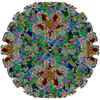



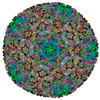

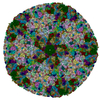
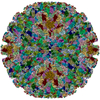


 PDBj
PDBj
